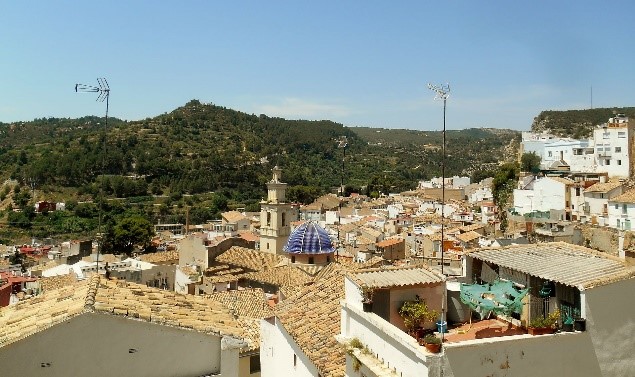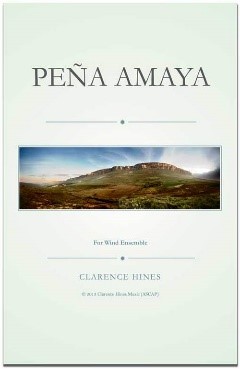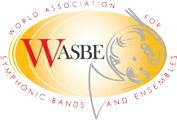Welcome to 
NEWS
WASBE 2019 BUNOL SPAIN TOP TEN SCORES

This was a great conference to experience, marvellous weather, wonderful hospitality and great organisation despite the Spanish love of mañana to explain their characteristically flexible approach to time. Because of rehearsals with the band from Villar del Arzobispo I was unable to attend any of the evening concerts until the final day; however there were 10 works which I would happily programme, if I had a band to work with. Highly recommended.
Composer |
Work |
Duration |
Performers |
Publishers |
Pas de Quatre |
13.50 |
Union Musical Santa Cecilia del Villar Arzobispo |
Composer |
|
Alarcon |
Symphony no 2 |
23.00 |
Banda Sinfonica de FSMCV |
Composer |
Hill Dance |
7.43 |
Banda Sinfonica Municipal de Valencia |
Composer |
|
Symphony in Bb |
26.55 |
Banda Sinfonica Union Musical de Lliria |
Robert Martin |
|
Hines |
Peña Amaya |
6.30 |
University of North Florida Wind Symphony |
Composer |
Morning Songs in Hiroshima |
10.40 |
Union Musical Santa Cecilia del Villar Arzobispo |
ItoMusic/Brain (Bravo) |
|
Transcending |
4.10 |
Sydney Conservatorium of Music Wind Symphony |
Composer |
|
Symphony 2 |
20.24 |
Union Musical Santa Cecilia del Villar Arzobispo |
Composer |
|
Strens |
Danse Funambulesque |
11.00 |
Banda Sinfonica de FSMCV |
HaFaBra |
Audivi Media Nocte |
22.00 |
Banda Sinfonica Amigos de Branca |
Beriato |
|
Three other recommended scores |
||||
Axt |
On the way to the Pena |
6.42 |
El Sistema |
Maecenas |
Koh |
Mindset |
16.00 |
Brain |
|
Pares |
Overture Richilde |
10.00 |
Bravo |
|
TOP 10 PIECES FROM WASBE 2019

Luis Serrano Alarcón/Pas de Quatre 13.50 Composer
https://www.youtube.com/watch?v=geftpxbuFQs
Played here by Barcelona Clarinet Players and the Lone Star Wind Orchestra/Eugene Miraglio Corporon
I was lucky enough to conduct this virtuosic piece with the Union Musical Santa Cecilia del Arzobispo with the superb Barcelona Clarinet Players, a quite brilliant and amusing ensemble. I always love Luis’ music, full of fireworks, witty and elegant.
Luis Serrano Alarcón/Symphony no 2 23.00 Composer
https://www.youtube.com/watch?v=rruyFu5m3XI
Performed on this Youtube by Gran Canaria Wind Orchestra
I was unable to get to the late evening concert which included this, but hearing it on You Tube I am sure that must have made a big impact. Alarcon has a knack of writing largescale symphonic movements fully scored but treating the ensemble like a wind ensemble, with great parts for each section and wonderful solo passages alternating with the full band. His musical language is traditional, generally quite romantic but never hackneyed or cliché ridden. The third movement is really good light music and might stand by itself in a concert, especially to show off you solo trombone, a delicious, charming French waltz, while the fourth is splendidly energetic, a wild romp reminiscent of the music of Les Six. If you are seeking a largescale work this is well worth listening to this, or to Alarcon’s First Symphony.

David Avshalamov/Hill Dance 7.43 Composer
https://www.youtube.com/watch?v=_Rn-WXs40Po
Played here by University of North Texas conducted by Jack A Eady
One sadness for me at the conference was an inability to attend any of the late night concerts, which began at 10.30 in the superb Auditorio de San Luis, a wonderful amphitheatre seating 3,000. Because of rehearsals at Villar del Arzobispo I could only catch the final concert. My outstanding work in this concert Hill Dance by David Avshalomov.
On his superb web site the note on this states :
Lively Bulgarian-style 5/8 folk dance up in hill country. Showy solos for Eb, Bb and bass clarinet. Slower middle section with Jewish-flavor circle-dance, almost drunk. Wild loud fast ecstatic ending building to full band.
Paul Fauchet/Ouverture (Symphonie in Bb) 26.55 Robert Martin
https://www.youtube.com/watch?v=jZ4l2N6CG1som/watch?v=7lLq_zCpLXs
Performance on youTube by the French National Police Band
Written in 1926, this is a welcome addition to the few romantic works for the symphonic wind band. Composed for the Garde Republicaine, the work has been edited by Miguel Etchegoncelay who conducted a fine performance of the first movement with the Banda Sinfonica Union Musical de Lliria.

Clarence Hines/ Peña Amaya 6.30 Composer
https://www.youtube.com/watch?v=jnt8srWSsio
I found this to be a sensitive, charming work, played on this video by Gordon Brock and the University of North Florida but at WASBE conducted by Erin Bodnar.
Clarence Hines writes:
This piece evokes memories of an afternoon hike along the mountain trails of Peña Amaya, which is located in the province of Burgos in northern Spain. After learning of the historical significance of this landmark, with all of its ancient and medieval ruins, and after hearing a work from the Codex Las Huelgas, a medieval manuscript of Gregorian chants with origins in the region, I was inspired to compose this piece.

Yasuhide Ito Morning Songs in Hiroshima 10.40 Composer
https://www.youtube.com/watch?v=fx-GyCEs9-Q
Played here by Yasuhide Ito’s Senzoku Gakuen Green Tie Wind Ensemble, but at WASBE he conducted the Union Musical Santa Cecilia de Villar del Arzobispo.
This is a deeply felt plea against was and in particular the threat of nuclear bombs. The work is in fact a miniature tone-poem, beginning with a long, solo passage for unison clarinets, gradually joined by other instruments. The intensity is increased, but suddenly dissolves into a return to the opening theme set against chattering birdsong over menacing pedal notes. A sinister militaristic march is interrupted for another return to the music of the opening, again interrupted painfully by screeching woodwind, until a return to peace for the coda.

Christopher Marshall/Transcending 4.10 Composer https://www.youtube.com/watch?v=8p6Bi7WWnL0
This is a quite extraordinary piece, reminiscent of the shifting colours and chords in Farben, the third movement of Schoenberg’s Five Pieces for Orchestra; there is no melody until a fragment of flute appears right at the end, a quite beautiful piece, superbly played by John Locke and the Sydney Conservatorium of Music, highly recommended.
James Stephenson/Symphony no 2 20.24 Composer

“Voices”
https://www.youtube.com/playlist?list=PLKmHwDyDMwfErAMVl6NJYoj1X5gngQbUc
Played on this recording by the US Marines
At the CBDNA Conference last February I was very struck by Stephenson’s Concerto for Trtumpet and Wind Orchestra. A distinguished carrer as a professional trumpet has shaped his music, which is sumptuously scored, lyrical, but full of excitement and emotion. The tragic first and third movements of this Symphony, featuring a solo untrained voice, frame a brilliant scherzando in 7/8. The composer writes:
Symphony no 2 was written for the US Marines Band. Used together, voices can express opposition, or unification. It occurred to me that all of these and more can be represented within the scope of a wind ensemble. The symphony No. 2 is an exploration of as many voices as I could formalize, resulting in a kind of concerto for wind ensemble. The culmination of the symphony is one of a unified voice, bringing together all of the different “cultures” and “individual voices” of the wind ensemble to express an amassed vision of hope and love; a vision I believe to be shared throughout all the world, yet disrupted continually by misguided and empowered individuals.
Jules Strens/Danse Funambulesque 10/10 Hafabra
https://www.youtube.com/watch?v=sW7ErRCeOAY
Performance on YouTube from WASBE 23019
Jules Strens has the dubious distinction of having his biography excised from the latest editions of the Dictionaries of Music of both Grove and Baker, the latter along with the great arranger Robert Russell Bennett. A student of Paul Gilson, he was a member of the Group des Synthétistes, all Gilson pupils, who endeavoured to embrace the new compositional ideas of Ravel, Debussy, Stravinsky and others within a traditional framework. His compositions include opera, orchestral and chamber music, a wind quintet, wind trio and two works for horn quartet. Danse Funambulesque was originally written for orchestra in 1925, and rescored for Symphonic Wind Band in 1930, dedicated to the conductor of the Belgian Guides, Arthur Prévost with admiration et reconnaissance artistique. The opening Andante with evocative solos for flute, oboe and clarinet, is reminiscent of the music of Ravel, perhaps especially his song cycle Scherherazade Shérhérezade though this indolent atmosphere is constantly interrupted by more energetic music which eventually dominates and turns into an increasingly frenetic dance. The scoring is for the usual European lineup of the Belgian Guides or the French Garde Republicaine, with multiple clarinets and in addition to the normal brass instruments, a team of keyed Bugles, Alto Horns in Eb, and Bombardons in both Bb and Eb. The work is in my opinion a worthy companion piece to Florent Schmitt’s Dionysiaque and is quite unjustly neglected.

Oliver Waespi/Audivi Media Nocte 22.00 Beriato
https://www.youtube.com/watch?v=ko7f5SM6j5M
played at WASBE by Banda Sinfonica C.I.M La Armonica.
Played on this video by Associacion de la Musica de Yecla
Originallywritten as a test piece for a brass band contest, Waespi has done a fine job transcribing the work for wind orchestra, with the obligatory brass solos emerging naturally from the texture.
Audivi Media Nocte (I heard at midnight) is based on the eponymous motet by Thomas Tallis from the 16th Century – a work that holds great fascination for Oliver Waespi. During the process of composition, various chord sequences and rhythmical structures emerged that led the work in the direction of a musical drama, with elements of a concerto grosso and solos for different soloists. Wind Repertory Project
-Program Note by publisher
THREE MORE SCORES WORTH LOOKING AT
Christian Axt/On the way to the Peña 6.42 Maecenas
https://www.youtube.com/watch?v=_I1C8xueciM
Played here by Simon Bolivar Symphonic Band El Sistema
A Peña is a meeting place or grouping of musicians or artists, either in Spain (where it is known as Peña Flamenca) or in various South American usually in the form of Nueva Canción, the kind of music popularised by musicians such as Violeta Parra and Victor Jara in the 1960s and early 1970s. In Chile in particular, the term came to mean a cheap, popular venue where folk music was played and simple food and drink were available.
Chang Su Koh Mindset 16.00 Minutes Brain
https://www.youtube.com/watch?v=iB0M1rgK-vI
I first heard this dramatic piece in Taiwan at the WASBE Conference of 2011. I was impressed by this and the same composer’s Lament and so I was delighted to conduct it is Tokyo in June.. After a quiet introduction on percussion, there is an exciting 7/8 passage, not dissimilar from the second movement o the Stephenson Symphony no 2. A second section is scored for woodwind, lyrical shifting chords which dissolve onto each other. I found this passage very moving, with a huge climax giving way to a very beautiful ending, with a brief tempestuous coda. Highly recommended if you want a fine example of contemporary Japanese repertoire.

Gabriel Parès/Ouverture Richilde 10.00 Bravo Music
https://www.youtube.com/watch?v=_2Wu-IZ3h-A
Played by the Garde Républicaine
A discussion about the paucity of romantic works for wind orchestra reminded me of this piece which I first heard played in Hong Kong by the Philharmonic Wind of Siingapore conducted by Leonard Tan.
Gabriel Pares was an outstanding student at the Conservatoire de Paris, winning first prizes in composition, cornet and harmony. He studied composition with Léo Delibes. Pares ultimately assumed leadership of Orchestre de la Garde Républicaine in 1893. During that tenure (1893-1910) he wrote approximately 90 original works and 50 arrangements.
His Traite d' Instrumentation et d' orchestration a l' Usages des Musique Militaires set the performance standard for French wind orchestra. His skills gave rise to the golden age of Orchestre de la Garde Républicaine and established Pares as the French equivalent of John Philip Sousa.
Richilde Overture remains to be a favorite amongst Pares’ many works. This dramatic piece, in standard overture style, is strongly late romantic. The beginning horn statement and successive themes, all superbly orchestrated, draw towards a profound conclusion.
The overture’s original instrumentation followed that of Orchestre de la Garde Républicaine, with frequent use of the saxophone family. Such full instrumentation sought an orchestral sound and effect. This arrangement uses contemporary wind orchestra instrumentation to preserve the atmosphere of the original
NEW RECORDING FROM MARK MORETTE
INTERNATIONAL REPERTOIRE RECORDINGS
VOL.12 CLEVELAND STATE UNIVERSITY SYMPHONIC WINDORCHESTRA AND CHAMBER WINDS Cleveland winds ROYAL NORTHERN COLLEGE OF MUSIC WIND ORCHESTRA - (54372 – MCD) Conductors Birch Browning, Timothy Reynish and Clark Rundell. Euphonium David Childs |
||
Scottish Dance Suite |
Thea Musgrave |
Scotland |
Variations on the Wee Cooper of Fife |
Cedric Thorpe-Davie |
Scotland |
Euphonium Concerto |
Adam Gorb |
England |
Aue |
Christopher Marshall |
New Zealand |
Dance Sequence |
Marco Putz |
Luxembourg |
Serenade for Sophia |
Guy Woolfenden |
England |
Welsh Airs and Dances |
Alun Hoddinott |
Wales |

 Visit the World Association for Symphonic Bands and Ensembles website
Visit the World Association for Symphonic Bands and Ensembles website